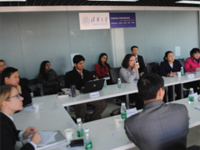Registration
Thank you!
You will receive an email confirming your registration.
IMGXYZ3027IMGZYXIn November 2010, U.S. President Barack Obama visited India, followed by Chinese Prime Minister Wen Jiabao the following month. The Carnegie-Tsinghua Center for Global Policy hosted the first in its “China and South Asia’s Future” seminar series, bringing together rising experts in the field to discuss the impact of those visits on Chinese-Indian-U.S. relations. Carnegie’s Lora Saalman moderated and presented at the event.
Achievements and Challenges of U.S.-India Relations
- U.S. Emphasis on India: Song Haixiao, a post-doctoral candidate at Renmin University’s School of International Studies, maintained that Obama did not place a particularly strong emphasis on relations with India early in his presidency, which left New Delhi somewhat anxious about the future of bilateral relations. Song said that India hoped Obama’s recent visit might restore and improve U.S.-India relations. However, he suggested that ties between the two nations would remain weak, as the agreements reached during Obama’s visit did not satisfy the high expectations of the Indian populace.
- Warm Economy and Cold Politics: India’s disappointment with Obama’s visit created what he described as a de facto state of “warm economy, cold politics” (jingji huore, zhengzhi bingleng) between the two nations. Although economic relations between the countries are strong, diplomatic relations are somewhat strained, particularly since both the United States and India view their relationship with an eye toward how it affects their bilateral relations with China. Binod Singh, a lecturer at the School of International Studies within the Beijing Foreign Studies University, added that the Indian opposition has made Obama’s visit part of the ongoing domestic debate as to whether or not India has sacrificed its sovereignty to the United States.
- Agreements and Differences: Long Xingchun, a PhD candidate at Beijing Foreign Studies University, argued that while India and the United States are both great democratic civilizations, the fact that one is a developed country and the other is still developing creates tensions. Lou Chunhao of the China Institute of Contemporary International Relations emphasized that the existence of multiple interest groups in both nations elicits numerous gaps between U.S. and Indian policies. Yet Lou argued that, despite these divergent interests and tensions, the United States and India are likely to remain allies and, at least in the near term, are unlikely to engage in confrontation. Kalyan Kemburi, a consultant for the James Martin Center for Nonproliferation Studies, agreed. He argued that Indo-U.S. relations have been recently strengthened by economic and political policies, such as the $14 billion worth of economic agreements between the two and Obama’s call for Pakistan to stop providing a safe haven to terrorists, a foreign policy priority for India.
- U.S. Return to the Asia-Pacific Circle: Yang Xiaoping, assistant researcher at the Institute of Asia-Pacific Studies at Chinese Academy of Social Sciences, suggested that U.S.-India relations can be summed up by four U.S. goals:
- Expand trade to better recover from the economic crisis;
- Regain influence in the Asia-Pacific region;
- Mediate the rise of certain emerging countries;
- Lessen the outward manifestations of China’s “tough diplomacy theory.”
Yang argued that Obama’s visit promoted India’s regional status, along with U.S.-India bilateral relations. She suggested that China’s pursuit of what she described as a “multipolar world, unipolar Asia” (duoji shijie, danji yazhou) conflicts with the U.S. pursuit of a “multipolar Asia, unipolar world” (duoji yazhou, danji shijie).
- Expand trade to better recover from the economic crisis;
- Nuclear and Aerospace Shifts: Saalman noted that Obama has recently taken several steps to extend the U.S.-India Strategic Partnership, including removal of several key military and civilian industries from the U.S. Entity List and support for India’s membership in the Nuclear Suppliers Group (NSG), Missile Technology Control Regime (MTCR), Australia Group, and Wassenaar Arrangement. These moves permeate India’s civil and military aerospace and nuclear industries, even as they are criticized by some members of the international community, who argue that India’s 1974 peaceful nuclear explosion was one reason behind the NSG’s establishment. Saalman asserted that the arms control regime as a whole would be profoundly impacted if India were to join these groups, giving the country the ability to shape new norms and regulations from within the system.
Achievements and Challenges of Sino-Indian Relations
- The Media Factor: The Indian media has a systemic lack of understanding about China, Singh said, leaving most media coverage of China confined to Beijing’s economic reforms. Chen Qi, associate professor in Tsinghua University’s International Studies Department, pointed out the significant difference between mainstream media reporting on China and what he described as “extreme” (jiduan) reporting. Long agreed, suggesting that much of this stems from poor translations of Chinese reports within foreign media. He argued that Chinese media is often simply responding to commentary in the Indian press, creating a cycle of exaggerated reporting. An audience member who formerly worked at a prominent Chinese newspaper noted that sensationalized topics are more attractive to customers and therefore more appealing to newspapers.
- Flexible Triangular Relationship: Kemburi suggested that the United States supports India’s permanent membership in the United Nations Security Council (UNSC) as a balance to the influence of China and other members within the organization. He added that China has not directly supported India’s permanent membership, perhaps in part due to Beijing’s close relationship with Pakistan and to China’s desire to avoid giving too much power at the UN to a strong neighbor. Long added that the relationship among China, India, and the United States is a flexible triangle, which he described as unlikely to harden into direct confrontation. In terms of politics and ideology, the United States and India may have more in common with one another than with China, but China and India face similar challenges as developing countries. Additionally, China is a major trade partner for both United States and India. These factors, Long concluded, diminish the chance for conflict.
